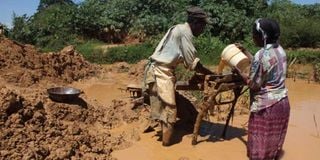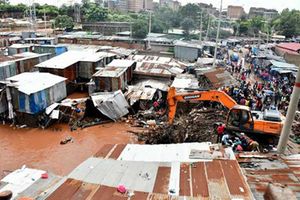How Masiyenze gold mine saved Kakamega villagers

Artisanal miners prospect for gold in Rosterman in Kakamega County.
The deafening sound of machinery crushing stones at a mine in Masiyenze village, Kakamega County, can be heard up to a kilometre away.
Masiyenze is a village in Savane sub-location, Kakamega South sub-county, which for many years was associated with criminal gangs involved in the abuse of drugs and illicit alcoholic beverages.
Unemployed youths who had dropped out of school were associated with the criminal activities in Masiyenze.
The village was divided into two parts: Masiyenze A and B, each with a population of about 2,000, and each headed by a village elder.
The mine is located on a hill along a road that runs through the village from the Museno trading centre on the Kakamega-Kisumu road towards Savane and on to Mululu in neighbouring Vihiga County.
Masiyenze is one of the formerly abandoned gold mining sites in Kakamega County.
Mining has resumed at the former Rosterman mines in Kakamega town and at several other sites in Ikolomani Constituency, including Lirhembe and Bushiangala.
In Masiyenze, small-scale mining started five years ago and gained momentum two years ago following government plans to build the country's first gold refinery.
The mining has attracted traders from as far afield as Migori and other parts of the country, who have invested heavily in equipment such as generators, water pumps and rock crushers.
Masiyenze was one of the places in the Western Region where colonial administrators settled, attracted by gold mining in the 1930s.
According to residents, part of an open field at Masiyenze market served as a golf course for colonial administrators before they abandoned mining and left the country in the 1950s.
The area is used by villagers as an open market where women display their wares and sell vegetables and other food.
A group of youths gather in one corner of the site to play games or just chat while they wait to join their colleagues in the mines.
The locals have taken to artisanal mining in an attempt to find the riches they believe are still underground, long after the colonial administrators abandoned the mines.
Mining has brought together men, women and young people, who mix as they carry out various activities, including carrying soil in basins to an open area for sifting.
The artisanal miners use rudimentary equipment to dig the tunnels in search of the veins that are believed to contain gold, while they dig up the rocks, which are later crushed before being processed to check for traces of gold.
The artisanal miners work in groups of 30 in each of the pits and have a supervisor to check on safety and provide guidance on how the work should be carried out.
Over the past three years, the village has seen an influx of villagers who have turned to gold mining in the hope of making a fortune and improving their livelihoods.
Savane sub-location deputy chief Naftali Mutsotso has served as administrator for more than 20 years and says crime in the village has decreased since the villagers turned to mining.
"In the past, gangs of young men would roam the village at night armed with machetes and clubs, attacking residents and robbing them of valuables," said Mr Mutsotso.
Incidents of drug abuse, illegal brewing and theft of livestock from homes were rampant.
Mr Josephat Agala, who has worked in the mines for several years, said he had managed to support his family and pay his son's university fees.
"I started working in the mines in 2002 and have never looked back, because on a good day you can make a fortune. Sometimes we work for several months without finding anything substantial, but we never give up," said Mr Agala.
He said he had helped train several youths who had completed secondary school and were unable to enter universities and other tertiary institutions to become artisanal miners.
"One of the things we have done is to ensure that we use skilled and experienced colleagues who have worked in the mines before to build the structures and ensure that the pits don't collapse on the miners," says Mr Agala.
Mr Paul Ndung'u, from Thika town in Kiambu County, moved to Masiyenze village 14 years ago after selling his hotel business, which was not doing well.
"When I came to Kakamega, I was living in a hotel at Khayega market trying to figure out what to do next. I had Sh150,000 with me and I didn't want to gamble and lose the money," said Mr Ndung'u.
He decided to visit one of the mines and find out what was going on. His friends persuaded him to join the artisans and learn the trade.
"After working in the mines for a few months, I saw an opportunity and decided to go for it," said Mr Ndung'u.
He bought two stone crushers and pumps to extract water from the pits. The equipment is rented by the miners for a fee.
"I sell the earth for Sh30,000 per truck to buyers who process it to look for gold. I've invested almost Sh2 million in the equipment and I'm happy with the way things are going," said Mr Ndung'u.
He has big plans to buy more equipment to hire out to the growing number of artisanal miners in the region.
The artisanal miners hope to reap big rewards for their efforts when the planned Sh2 billion gold refinery in Lidambitsa is completed.





